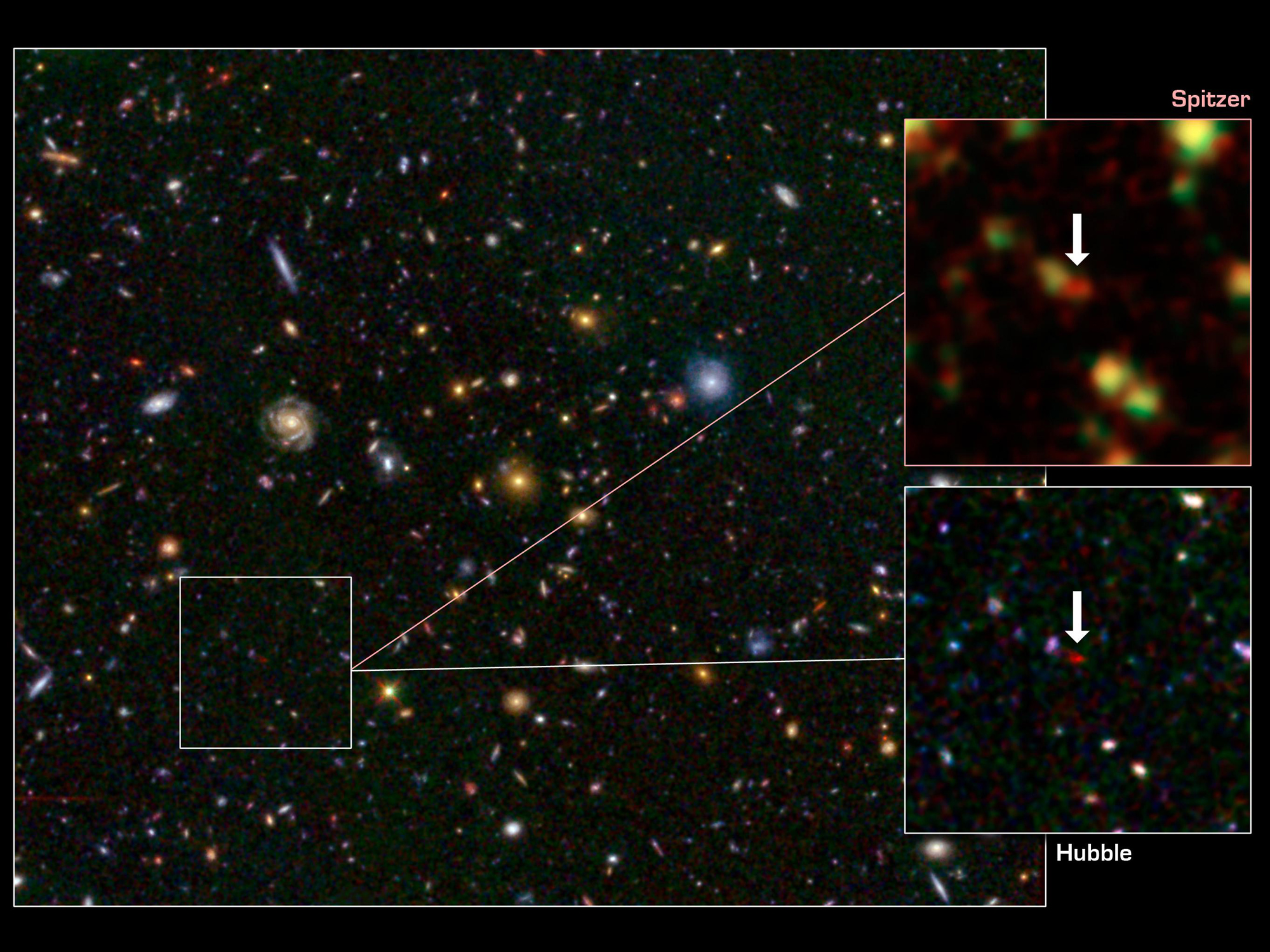Rare Galaxy from 'Dawn of Time' Photographed

An ancient galaxy that formed just after the birth of the universe has been photographed by telescopes on Earth and in space, and is the brightest galaxy ever seen at such remote distances, astronomers say.
The blob-shaped galaxy, called GN-108036, is about 12.9 billion light-years away and appears as it existed just 750 million years after the universe began. The universe, for comparison, is about 13.7 billion years old.
But the sheer distance to the galaxy isn't the only thing to intrigue scientists. The galaxy is also creating stars at a furious pace, making it a rare cosmic find. NASA officials described the galaxy as shining from the "dawn of time," with star formation inside it occurring at a "shockingly high rate."
A photo of the rare galaxy released by NASA shows the object as a red blob surrounded by other bright galaxies.
"The discovery is surprising because previous surveys had not found galaxies this bright so early in the history of the universe," said Mark Dickinson of the National Optical Astronomy Observatory in Tucson, Ariz., in a statement announcing the find on Wednesday (Dec. 21). "Perhaps those surveys were just too small to find galaxies like GN-108036. It may be a special, rare object that we just happened to catch during an extreme burst of star formation."
An international team of astronomers discovered galaxy GN-108036. It was initially spotted by Japan's Subaru telescope atop the volcano Mauna Kea in Hawaii, and its ultra-far distance was confirmed using the Keck Observatory, also on Mauna Kea. NASA's Hubble Space Telescope and infrared Spitzer Space Telescope were then used to take better images of the galaxy. The research is detailed in the Astrophysics Journal.
"We checked our results on three different occasions over two years, and each time confirmed the previous measurement," said study leader Yoshiaki Ono of the University of Tokyo.
Get the Space.com Newsletter
Breaking space news, the latest updates on rocket launches, skywatching events and more!
Galaxies forming within the first few hundreds of millions of years after the Big Bang were much smaller than the ones astronomers see in later periods because they had not yet built up most of their bulk. So seeing a galaxy like GN-108036, which is small yet exceptionally bright and teeming with star formation, came as a shock. [The Universe to Now in 10 Easy Steps]
"We had never seen such a vigorously star-forming galaxy at a comparable distance until the discovery of GN-108036," Ono said.
Astronomers measure the distance to objects in space by measuring how much their light is stretched toward the red end of the light spectrum, a factor known as "redshift." The greater an object's redshift, the older and farther away it is, NASA officials explained.
GN-108036 has a staggering redshift of 7.2, one of the few objects known with a redshift larger than 7. Just two other objects have been confirmed to be older and more distant than GN-108036, NASA officials said.
The newfound galaxy is so ancient that it and others like it may have played a role in the transition from the so-called "dark ages" of the universe — a period before the first stars formed when a thick hydrogen fog permeated the cosmos — into the universe we see today.
"This was therefore a likely ancestor of massive and evolved galaxies seen today," said Bahram Mobasher, a team member from the University of California, Riverside.
You can follow SPACE.com Managing Editor Tariq Malik on Twitter @tariqjmalik. Follow SPACE.com for the latest in space science and exploration news on Twitter @Spacedotcom and on Facebook.
Join our Space Forums to keep talking space on the latest missions, night sky and more! And if you have a news tip, correction or comment, let us know at: community@space.com.

Tariq is the Editor-in-Chief of Space.com and joined the team in 2001, first as an intern and staff writer, and later as an editor. He covers human spaceflight, exploration and space science, as well as skywatching and entertainment. He became Space.com's Managing Editor in 2009 and Editor-in-Chief in 2019. Before joining Space.com, Tariq was a staff reporter for The Los Angeles Times covering education and city beats in La Habra, Fullerton and Huntington Beach. In October 2022, Tariq received the Harry Kolcum Award for excellence in space reporting from the National Space Club Florida Committee. He is also an Eagle Scout (yes, he has the Space Exploration merit badge) and went to Space Camp four times as a kid and a fifth time as an adult. He has journalism degrees from the University of Southern California and New York University. You can find Tariq at Space.com and as the co-host to the This Week In Space podcast with space historian Rod Pyle on the TWiT network. To see his latest project, you can follow Tariq on Twitter @tariqjmalik.
